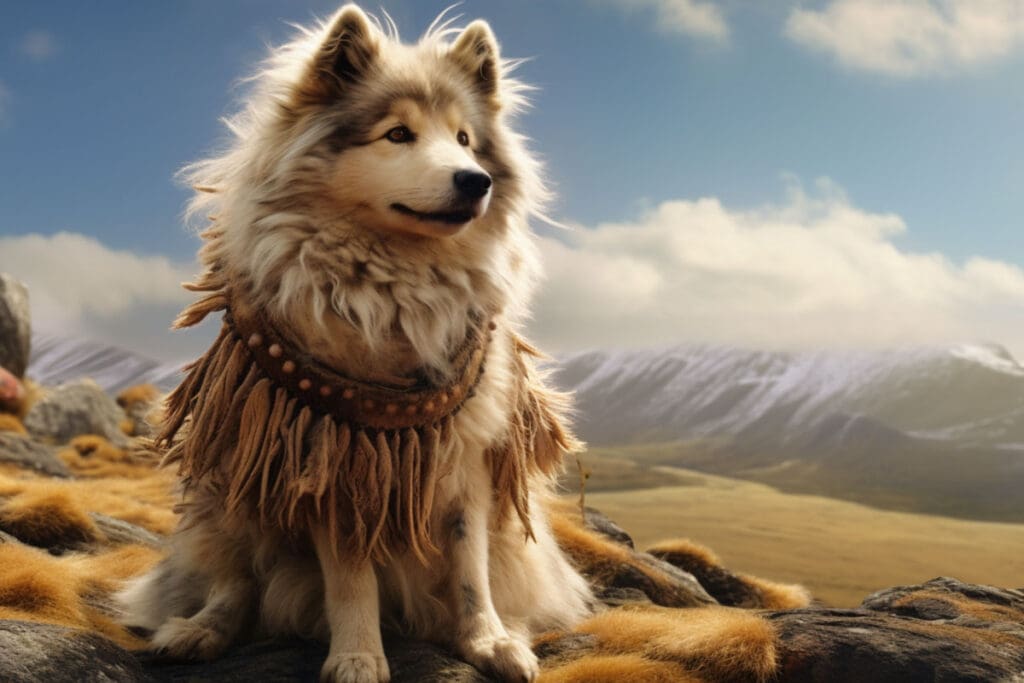
Humans have raised and bred dogs as guardians, hunters, and companions for thousands of years. However, one group of North American indigenous people bred woolly dogs for a completely different purpose.
Dogs were introduced to the Americas from Eurasia about 15,000 years ago. But one group of “woolly dogs” has been dated by archaeologists to only about 5,000 years ago. In fact, oral histories suggest their history is even longer. Nonetheless, these dogs aren’t the product of evolution but rather human breeding efforts.
These so-called “woolly dogs” are not around today. The breed these dogs originated from went extinct in the 20th century. Their appearance was somewhat like the modern spitz breeds. This would include Samoyeds, American Eskimo dogs, or Shiba Inus. However, they differed in that these “woolly dogs” had long, mountain goat-like hair. Their fur was white, and they had pointed ears and curly tails.
These breeds originated among Coast Salish peoples. These were Salish-speaking Indigenous groups in Washington State and British Columbia.
Read More: 5 Incredible Senses That Animals Have and Humans Don’t
World’s Only Remaining Sample of “Woolly Dog” Pelt Studied
The reason we know about these dogs and their true histories is because these animals still hold great importance among Coast Salish communities. Unfortunately, much of that history had been clouded by centuries of colonialism. However, most Salish people have kept the stories of these remarkable dogs alive.
Luckily, there remains a single pelt of a Salish woolly dog, who was named Mutton. It is the only known specimen in the world. Mutton died of natural causes and his pelt has been held by the Smithsonian since 1859. The specimen lay mostly forgotten in the Smithsonian’s faults until historian Candace Wellman rediscovered the pelt in 2002. Mutton’s pelt seemingly holds the last genetic clues from his breed.
Researchers at the Smithsonian National Museum of Natural History, in partnership with Coast Salish communities, are working together to clear up the fuzzy past of this breed.
“This was a wonderful opportunity to weave the most advanced Western scientific methods with the most entrusted traditional Ancestral knowledge,” said Michael Pavel, an Elder from the Skokomish/Twana Coast Salish community in Washington, and co-author of the study. “Together, these two bodies of knowledge raise the level of understanding of the woolly dog, its origins, its purpose, and its contribution to our way of life, in what it did, and does, and will continue to mean to us as Indigenous people in the Salish Sea territory.”
The Results
The results of genomic testing of Mutton’s pelt were published in a new study in the journal Science. For the first time, scientists have been able to narrow in on the specific genes that yielded the lush coat this breed possessed.
Mutton was born in the late 1850s after settlers and their European dogs arrived. The study revealed that Mutton remained primarily related to precolonial dog breeds. However, the most important finding of this study was that it supported what the Coast Salish have long known: that Indigenous peoples actively bred these dogs. They cared for and protected the finely tuned genetics of the woolly dog, even after European settlers arrived.
In purifying the breed, some dogs were kept secluded on islands to prevent mixing them with other breeds. This occurred even after the arrival of settlers. These accounts match up with long-told stories and the knowledge of Coast Salish people.
Connections to Woolly Mammoths and Humans
Researchers looked at 11,000 different genes to identify those that could have helped yield the luxurious fur of Mutton’s breed. They found 28. Interestingly, some of those they found were similar to those found in the genomes of woolly mammoths. One gene was also found in woolly-haired humans. Another gene was found in dogs with curly hair.
Ultimately, researchers determined that Mutton was most genetically similar to precolonial dogs from Newfoundland and British Columbia. Around 85% of his genes matched up to these dogs.
The Surprising Reason Indigenous Peoples Bred Them
Throughout the ages, humans have bred dogs to serve as guardians, hunting assistants, and companions. But the indigenous Coast Salish people bred their woolly dogs for a completely different purpose.
Woolly dogs were bred specifically for their fur. The fur was sheared and the coats of the woolly dogs were used for a variety of textiles.
The fur was made into coats or blankets. The dog fleece was sometimes mixed with other materials, such as plant fibers, goat wool, or waterfowl down.
Read More: A Link Between Owning Cats and Schizophrenia? Researchers Find Evidence
Spiritual Connection With Animals
The indigenous Coast Salish people also had a spiritual connection with the animals.
“‘A dog is a man’s best friend,’ the old adage goes, but Salish woolly dogs – who were considered extensions of the family – were doted on by women,” said Michael Pavel, an Elder from the Skokomish/Twana Coast Salish community in Washington, and co-author of the study. “Blankets, robes, and regalia of the region incorporated the dog fleece, mixed with plant fibers, goat wool, and waterfowl down.”
“Wearing a woolly dog blanket wasn’t just like throwing on any old coat. The dogs were revered as spiritual creatures, and their fur retained not just heat, but prayers,” Pavel added.
Why Did the Dogs Disappear?
Previous research by some Western scholars speculated that when the Europeans arrived, their machine made blankets made the dog fleece blankets obsolete. Therefore, the need to breed dogs for their fur diminished. However, new research casts doubt on such observations, given the spiritual connection the indigenous people had with the dogs.
“That doesn’t pay attention to the cultural importance or 4,000 years of intentional breeding, and what it meant to have those blankets,” said Liz Hammond-Kaarremaa, Coast Salish textiles researcher at the Smithsonian and Vancouver Island University. “Hudson’s Bay blankets provided warmth, but they didn’t provide cultural protection.”
The reason the dogs disappeared was not because the Coast Salish communities gave up on the dogs due to the convenience of blankets from the Hudson’s Bay Company. The abandonment of the dogs had everything to do with the encroachment of Europeans and the lifestyle changes that were forced upon indigenous people.
Displacement, disease, and laws that were passed to restrict cultural practices were the reason, according to interviewees who spoke with the Smithsonian researchers. All of these factors led to the breed becoming extinct in the early 20th century.
Coast Salish Considering Breeding These Dogs Again
Now, Coast Salish community leaders are looking to the future, and examining the possibility of slowly breeding a new version of the woolly dog.
“That day is, I think, possible, and we may not have been able to do that without having some sense of the science from Audrey [Lin, of the Smithsonian] and her colleagues,” Pavel said. “That’s going to take some time, but that’s exactly what we did in the very beginning.”
“We didn’t know all we needed to know when the woolly dog came into our lives thousands of years ago, but over many years, we acquired the knowledge that was necessary for the woolly dog to share its power with us,” Pavel added.









